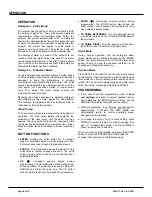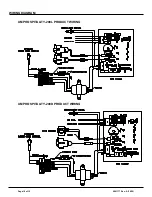
0901177 Rev: A (10/15)
Page 5 of 12
ELECTRICAL
Turn off all power before wiring the control. Check
with a voltmeter to ensure power is off.
Main Power Connection
One step-down transformer is provided with the UMP
control. Connect the high voltage side, through a switch
or circuit breaker in close proximity to the equipment
and marked UMP, to any 115/208/230 VAC power
source that is “on” when the dishmachine is “on” (i.e.
mains switch on dishmachine).
NOTE: The transformer provides power to both the
detergent and rinse circuits. The UMP will only operate
detergent or rinse when electrically signaled.
To wire main power connection:
(1) Check the voltage of the main power source and
make sure that it matches one of the three available
input voltages (115/208/230 VAC) of the
transformer inside the Ultra Micro-Pro.
(2) Remove all power from the dishwasher.
(3) Connect leads from the main power source to the
appropriate wires on the transformer.
* CAUTION: The UMP unit has high voltage connected
to the transformer. Always disconnect main power when
servicing the unit.
Remote Alarm
A remote 3 - 28 VDC alarm may be wired to the “alarm”
terminals on the circuit board. See wiring diagram on
page 10.
Pressure Switch Kit
For applications that do not have a dedicated rinse
signal from the dishwasher, the pressure switch can be
used to create a rinse signal using the transformer in the
unit (see wiring diagram for further details).
(1) Remove power from the dishmachine. Ensure that
power is removed from the dispenser.
(2) Locate the rinse injection fitting presently installed
on the dishmachine (if applicable). Near the
injection point, drill a hole for the pressure switch.
Drill the hole using a 11/32" bit and tap to 1/8" NPT.
(3) Wrap the threads of the pressure switch with 3 - 4
turns of plumbing tape, then install the pressure
switch into the drilled/tapped hole.
(4) Wire the pressure switch per the appropriate wiring
diagram on page 10.
Detergent Power Signal
A detergent power signal is required to activate the
detergent probe sensing or probeless initial charge. The
detergent signal can be jumpered from main power for
applications where the main power is controlled by the
on/off state of the dishmachine.
(1) Check the dishwasher for a power source that is
active during the washcycle only (example: the
magnetic contactor that controls the washpump
motor) and verify voltage. The Ultra Micro-Pro
circuit board will accept a detergent power signal of
14 - 240 VAC.
(2) Remove all power from the dishwasher.
(3) Connect leads from the detergent signal power
source to the detergent signal terminals on the
circuit board. Detergent signal must be the same
voltage as Rinse signal.
Rinse Power Signal
In addition to running the rinse pump, the rinse power
signal also triggers the detergent “recharge” injection if
probeless mode is selected
(1) Check the dishwasher for a power source that is
active during the rinse cycle only (example: the
rinse solenoid or rinse cycle light) and verify
voltage. The Ultra Micro-Pro circuit board will
accept a signal of 14 - 240 VAC.
(2) Remove all power from the dishwasher.
(3) Connect leads from rinse signal source to the rinse
signal terminals on the circuit board. Rinse signal
must be the same voltage as Detergent signal.
Conductive Probe Installation (if used)
(1) Install the probe in the wash tank below the water
level. It should be away from incoming water
supplies, near the recirculating pump intake, and 3
to 4 inches from corners, heating elements, or the
bottom of the tank. If an existing mounting hole
cannot be located, use of a 7/8" hole saw or punch
may be desired.
(2) Connect leads from the terminals on the probe to
the terminals marked “PROBE” on the circuit board.
(3) For best results, use 18 AWG multi-stranded
copper wire for the probe connection. Avoid running
the wire near high voltage AC lines.
ELECTRICAL
Содержание UMP Hospitality
Страница 9: ...0901177 Rev A 10 15 Page 9 of 12 PARTS DIAGRAM ...
Страница 11: ...0901177 Rev A 10 15 Page 11 of 12 NOTES ...






























